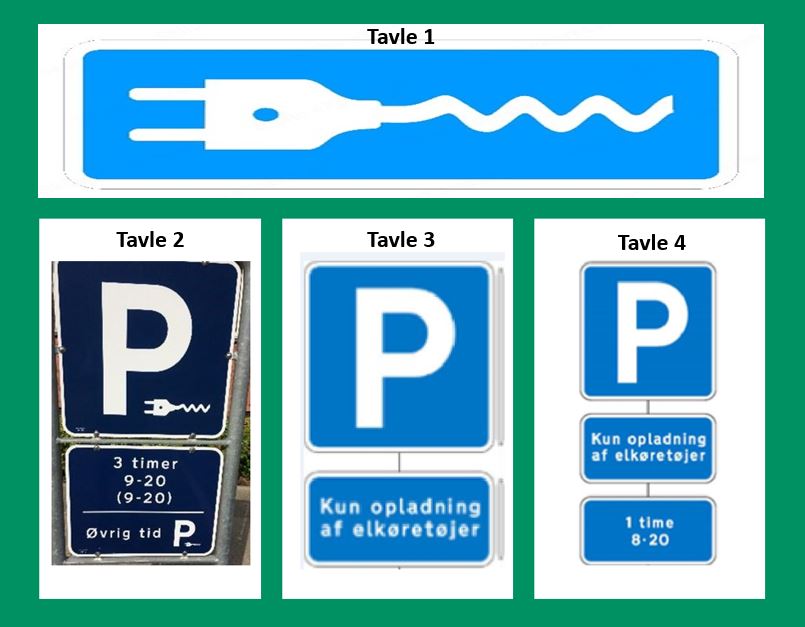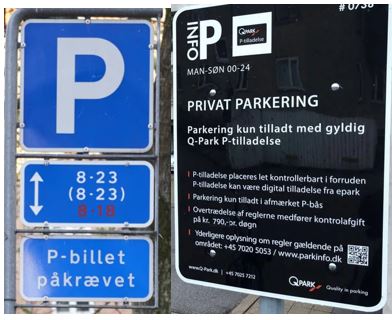Visiting Denmark in an EV
Are you visiting Denmark as a tourist or are you on a business trip and are traveling in an EV? Then you can get information and advice in terms of charging and parking your electric car on this page.

It can be a good idea to investigate the charging possibilities before you arrive in Denmark, if you’re visiting Denmark as a tourist in an EV. On Elbilviden.dk you can find a charging map with all the public available chargers in Denmark on one map. On the charging map you can sort and filter by charging speed, socket, and operator. In the upper left corner, you can see how many charging locations, chargers, and outlets there are within the area of the map that you have selected and sorted by.
There are apps where you can type in a route and then the app plans where on the route, it’s most optimal for you to charge based on the filters that you set up.
Charging as a service on hotels, summer houses and camping sites
There are many superfast chargers in Denmark, but if you’re visiting Denmark as a tourist, it’s our advice to you, that you search for hotels, summer houses and camping sites that offer charging to their guests.
In addition to hotels, summer houses and camping sites, a lot of malls and supermarkets also offer charging in their parking facilities.
How to pay for charging
In Denmark there is a legislation that says that all new superfast chargers after 1st of July 2022 should accept credit cards as payment, so here you can pay with your credit card. In addition to this, it is also possible to pay via the charging operator’s app. Most of the superfast chargers have been installed before this date, which is why installing the operator’s apps is a good idea.
On normal and fast chargers there are not the same rules. A few charges accept payment by card, but not all. Normally you can pay via an app or RFID chip. A few has the option to pay through a QR-code that directs you to a browser where you can pay via credit card.
You can also use E-mobility Service Providers (EMSP), that doesn’t necessarily own any chargers themselves, but offer charging via an app across different operators. Be aware that some of them have an extra fee for this service.
Other apps you need to download
It can be a good idea to download certain apps, before you get to Denmark. For example, you can check which operators you expect to use, and then download their apps beforehand. To get an idea of which operators you are most likely to use when visiting, you can check the charging map (link).
Besides the operator’s app, it can be a good idea to download apps that can help you with the following tasks:
- Help planning trips to optimize where to charge
- Apps where you can see the cheapest charging option on the specific charger
- Apps to use when parking
Language options when charging
On some of the chargers that has displays you can choose other languages such as English, German, and French. Its more common for fast- and superfast chargers to have displays, but some normal chargers have them as well. If the chargers do not have a display, you can access them via an app.
If your phone’s standard setting is not set to Danish, most apps would automatically be in English.
Parking rules for EVs
In Denmark we use different traffic signs to inform of the parking conditions for EVs:

Sign 1 (Tavle 1):
If this sign is under the normal parking sign:

it means that the parking spot only can be occupied by EVs.
Sign 2 (Tavle 2):
This sign says that the parking spot is only available for EVs. EVs can only park here for 3 hours (timer) in the following time period:
09:00-20:00 on weekdays (Monday to Friday)
09:00-20:00 on Saturdays
For other time periods the spot doesn’t have any time limit but can still only be used by EVs.
If the sign has any rules for Sundays, that time period is written in a red colour.
“Øvrig tid” translates to ”Other time periods”
Sign 3 (Tavle 3):
This sign says, that only EVs are allowed to park and has to be charging as well.
“Kun opladning af elkøretøjer” translates to ”Only for EVs charging”
Sign 4 (Tavle 4):
This sign says, that only EVs are allowed to park here and must be charging. The charging is limited to one hour (time) on weekdays between 08:00-20:00.
“Kun opladning af elkøretøjer” translates to ”Only for EVs charging”
Cities with free/ discount prices for parking EVs
In some of the bigger cities in Denmark, you need to pay for parking. Some of these cities offer free parking for EVs.
Copenhagen/ København
In Copenhagen municipality it is free to park on all public parking spots if you drive an EV, except underground parking facilities. Furthermore, EVs can park without any time restriction in the municipality’s three-hour parking zones. Be aware that these rules aren’t necessarily valid at parking spots where it’s required to charge while parking. You can read more about the parking rules in Copenhagen here.
You can distinguish between a public and private parking area by the color of the sign. The public ones usually have a blue sign, whereas the private usually have a black sign as seen below:

Frederiksberg
In Frederiksberg municipality it is free for EVs to park. You can read more about the parking rules in Frederiksberg here.
Aarhus
In Aarhus municipality EVs can park for free for four hours. After four hours EVs pay the normal parking fee. Therefor you need to register your parking in the app or automat. Read more about the parking rules in Aarhus here.
Which cables do i need when i charge?
You don’t need to bring any special cables when charging in Denmark since we use the same standard as the rest of Europe. If you need to charge directly from a household plug in Denmark, you need a three-legged socket with grounding that looks as following:

However, using a household plug should only happen in a case of emergency as it can result in melted cables if the wires are not dimensioned for it. If you do charge with a household socket, you should charge with a maximum of six amps/1,4 kW in max two hours.
Looking for more information?
If you are looking for more information and advice for when you are visiting Denmark in an EV, you can find more information on the following sites:
